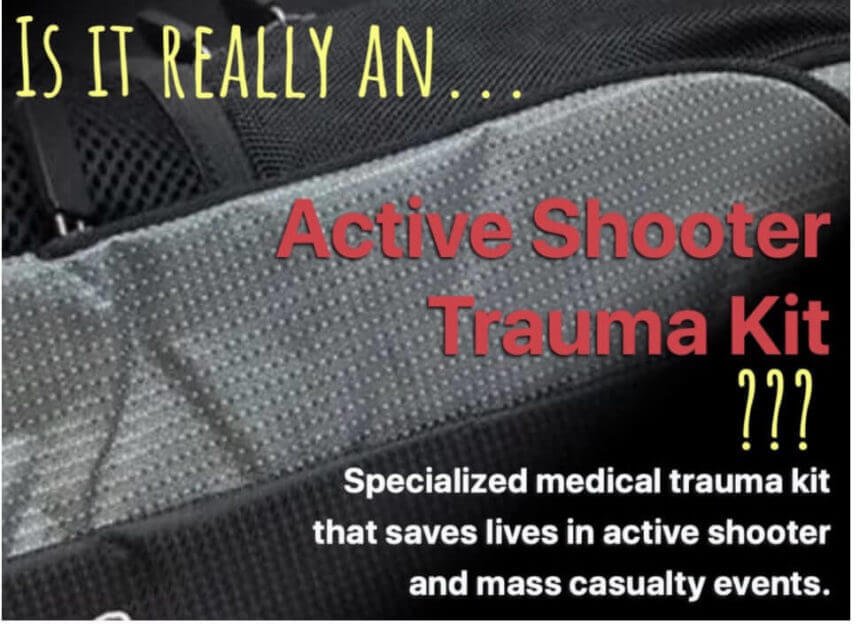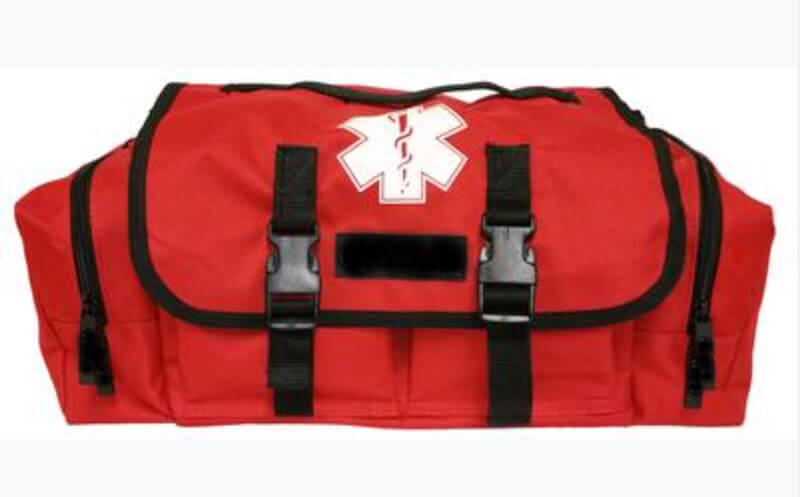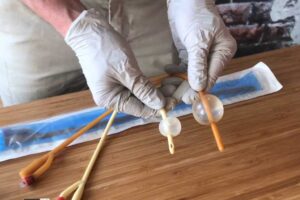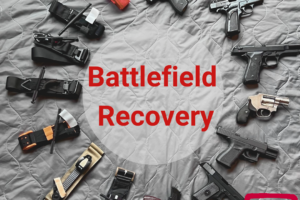
Gear Mongering: Why Stop the Bleed is becoming big business
- Posted by Mike Shertz MD/18D
- Categories Equipment
🕖 Reading Time, 10 minutes
The same week we learned about a School District in Florida who bought 800 cheap knock-off tourniquets, we also learned our daughter’s school initially purchased a tourniquet with no evidence to support it works. The school subsequently had to spend precious funding dollars to replace the unproven tourniquet once they got good advice on purchasing a TCCC recommended tourniquet, supported by medical evidence.
The next week, we learned a county North of us purchased “Active Shooter Kits,” that also contained unproven tourniquets. The County dutifully called a company to ask for help selecting items for their kits and were sold the kits we’ll discuss in detail below. The kits, in addition to containing the unproven tourniquet, have several other problems.
We now had three separate organizations buying three different sets of ineffective medical equipment.
We want people and organizations to understand what medical equipment they need, what they should purchase, and equally importantly, what to avoid. We don’t sell gear and don’t get kickbacks when students buy gear we believe is supported by the medical literature. We train people who want to help in emergencies, especially those in high-risk environments. We want everyone to get the training and supplies they need to be Force Multipliers for Good and make our communities more resilient.

In selecting items for our own IFAK (Individual First Aid Kits), also sometimes called trauma kits, bleeding control kits, etc, we first ask, “What is the mission statement?”
If the mission statement is, as suggested in the kit pictured here, to respond to “Active Shooter Traumas,” then that guides our discussion. What injuries would you expect to see in an active shooter situation? Gunshot wounds, right? Are you planning on managing all injuries, including those that are non-fatal? Or, are you looking to rapidly intervene on life-threatening injuries that can be managed prehospital?
Our IFAK packing list is specifically oriented around life-saving interventions (LSIs).
LSIs include management of extremity and junctional hemorrhage, decompression of tension pneumothorax, management of airway occlusion, and hypothermia prevention.
This “Active Shooter Trauma” kit does not come standard with any tourniquets. They are available at an extra cost. The company offers four options for tourniquets: two that are TCCC recommended, and two that are not. The two non-recommended tourniquets have no medical literature supporting their use.
There are many kits like this one on the market sold by many different companies. In fact, when we dug down into this kind of bag, the packing list here is not unique: Several companies are using different bags, with the same, inadequate packing list. We’re using this one because we know our friends up North who purchased these bags are now going to spend more taxpayer money re-stocking this bag with the actual equipment they need, not the items that came with the bag.
Using this so-called active shooter bag as an example:
Let’s look at the equipment they’ve chosen and see how it fits their mission statement for the bag: “Keeping this specialized medical trauma kit on hand saves lives in active shooter and mass casualty events.”
Our Analysis of this active shooter bag’s ability to save lives and offer LSIs
1 ea – Responder Bag
We recommend choosing your LSI medical equipment first and then finding a bag that fits it. Medical gear should be marked in red so you can easily find it. Bags with interior pouches and compartments keep equipment where it is expected to be. This bag has two outer pouches that zipper closed and a large interior compartment with no dividers or separators.
1 ea Tourniquet of your choice
You need to choose a tourniquet with clinical and scientific evidence it works. The TCCC committee has made this easier by recommending tourniquets that have evidence to support their use. There are literally dozens of tourniquets on the market now, including one that looks like a Home Depot zip tie with a timer, that have no medical evidence they are effective at controlling massive hemorrhage. Many of the unrecommended tourniquets may have some anecdotal experience that one guy, one time got it to work, and we’re glad if someone was saved, but they are not reliable and it’s not medically supported evidence.
If you are expecting to use this bag at a mass casualty event, you’re expecting more than one casualty. Additionally, there is DOD literature to say the average military casualty had 2.5 tourniquets placed. This vendor sells the bag with no tourniquets, or you can buy it with an upgrade to ONE, only ONE tourniquet.
1 ea – CPR Mask in case
There is no place for CPR in an active shooter or high-risk event. Survival from traumatic cardiac arrest is 0.5% (or 1 out of 200 arrests). Trauma patients arrest because they’ve lost substantial blood volume and their heart is empty. Attempting CPR in a high-risk environment puts the rescuer in jeopardy, has nearly zero chance of benefitting the casualty, and ignores other casualties who may still survive with proper treatment.
1 ea – Trauma Shears
We are always in favor of trauma shears, in fact, you can never have enough as they are easily misplaced at chaotic scenes. High-quality shears work better.
1 ea – Triangular Bandage
As a general matter, we like triangular bandages for IFAKS. Often referred to as cravats, they are a great, multipurpose piece of kit and can be an important part of an Active Shooter Kit. The triangular bandage sold elsewhere on the same website sells for $0.61 cents each and we believe this triangular bandage/cravat will suffer from the stretchiness problem we recently discussed in the Cravat blog post and thus is an adequate, but not great choice. The cheap civilian cravats we evaluated make mediocre improvised tourniquets, and poor wound packing bandages. Additionally, we always stock TWO triangular bandages in our IFAKs.
1 ea – Israeli Emergency Bandage
We stock Israeli Dressings, also called Emergency Trauma Dressings (ETD) in our kits, and agree with the 4” size included in this kit. However, the dressing in this kit appears to be a knock-off, and not the original made by PerSys Medical. We prefer equipment made to a known standard. The Persys Israeli ETD generates 60 mmHg pressure, which is half a normal blood pressure. This makes it a pretty robust pressure dressing for venous bleeding. The dressing included in this kit is only $1-2 cheaper than the Persys medical bandage. We don’t understand why anyone would buy emergency equipment where we don’t know the standard to which it is made.
2 ea – Blood Stopper Compression Bandage
A bandage is not a hemorrhage control tool, it’s basically a big bandaid. Technically, bandaging isn’t an LSI. The blood stopper bandage is as reasonable as any other and was one of the best bandages in the 1990s. The current ETDs are better. If you want more bandages, then we would stock more ETD/Israeli bandages. At least there are two of them. Even Taylor Swift knows bandaids don’t fix bullet holes.
2 ea – 3″ Conforming Stretch Bandage
This looks to be a knock-off version of Kerlix gauze. Kerlix is even more useful in an IFAK than a cravat. As a Special Forces Medic, we packed massively bleeding junctional wounds with Kerlix gauze with great success, as no hemostatic agents were available. We prefer a 4″ size of actual Kerlix brand, as it is 100% cotton, and better for packing than synthetic gauzes. Two rolls is a bare minimum in an IFAK, let alone a bag for “mass casualties.”
12 ea – 4″ x 4″ Sterile Gauze Pads
If your injury is so minor you only need 4 x 4 gauze, there are probably other casualties with injuries who need LSIs. If you really want 4×4’s, then take more Kerlix gauze and cut it to fit.
2 ea – 5″ x 9″ ABD Dressing
We’re not clear from this description what the kit will contain. However, the only ABD Pad the same website sells is a simple bandage, described as being for “heavy drainage, keep the wound dry and promote healing.” In an active shooter event, the only heavy drainage is likely blood. If it is coming from an abdomen, there is little a First Responder can do to fix this situation. The casualty needs a surgeon and an operating room. Putting the equivalent of a bandaid on the casualty in this environment is not helpful.
1 ea – Multi-Trauma Dressing 12″ x 30”
This looks to be more consistent with what we would call an abdominal dressing. Our view of an abdominal dressing is to make a “gut taco” to control an evisceration. Not unreasonable in a large bag of medical supplies but not an LSI. Nowhere in the MARCH mneumonic is evisceration management mentioned.
2 ea 2″ Cloth Tape
This is reasonable. Tape is always useful and as you’ll see below, chest seals don’t stick well to casualties and as the Asherman chest seals in this kit are one of the least sticky.
10 ea – Alcohol Prep Pads
Gunshot wounds are not sterile. If your patient developed a tension pneumothorax, it might be nice to clean the area before you use a needle to treat the condition. However, this kit does not include, nor mention this intervention. The presence of the alcohol prep pads here appears to be an effort to “pad” the contents.
1 ea – Emergency Mylar Blanket
Hypothermia in casualties is a critical and often overlooked issue. Cold blood does not clot and for this reason, the ‘H’ in the MARCH mnemonic is for Hypothermia Prevention. 9.3% of civilian trauma patients arrive at the hospital hypothermic. A drop of only 5 degrees Fahrenheit in body temperature corresponds to an increased mortality rate of 28%. These cheap, mylar blankets are better than nothing. A mass casualty bag should have more than one. Which casualty will you choose to keep warm? There are better options.
1 ea – Asherman Chest Seal (gunshot seal)
While the TCCC committee and their civilian counterparts at TECC recommend sealing all chest wounds, it remains unclear there is medical evidence to show this is necessary. Simple pneumothoraces do not kill casualties. The Asherman Chest Seal was the first of the commercial chest seals. It is vented, which we and the TCCC committee agree is crucial, to ensure an open pneumothorax does not turn into a tension pneumothorax. However, the Asherman is notoriously the least sticky of the chest seals, though none of them stick well. If you really feel you need to seal penetrating chest trauma, you’re going to need a lot of these in a mass casualty bag.
1 ea – Pair Nitrile Gloves
The website sells two kinds of Nitrile gloves: Blue and black. You cannot conduct a proper blood sweep with black gloves because you cannot see the blood on your hands. We wish people would stop selling the black gloves for any medical care. Based on how cheap gloves are, more than one pair would likely be a good choice in a mass casualty event.
1 ea – QuickClot
Its unclear whether this is old-school Quick Clot granules, or what is more traditionally called Combat Gauze. If you plan on putting a hemostatic gauze in your kit, Combat Gauze has the most evidence supporting it. Granular hemostatic agents fell out of favor over ten years ago as they “wash out” of actively bleeding wounds, are hard to get to the point of bleeding deep inside a wound, and in military settings, frequently blow into everyone’s eyes and faces with rotor wash.
Based on discussion with the group up North, their kits contained granules, not Combat Gauze. Hemostatic gauze is not cheap. If you’re planning on packing wounds with hemostatic gauze, you’re planning on using one roll per packed wound. A bag for mass casualties should have more than one roll.
Conclusion? This bag does not meet the mission statement and is not a good choice for addressing LSIs
As this bag’s company indicates on their website, in “mass casualty or active shooter situations, you need a kit with all the right products.” In our minds, that means dependable, reliable, and tested products and equipment.
This kit does not support their purported mission statement. While something is better than nothing, would you want to use a dollar store fire extinguisher, with no proven efficacy if your house was on fire?
Don’t fall prey to Gear Mongering, get training, get educated, decide which emergencies you can and will be prepared for and buy reputable supplies in support of your mission statement.

Dr. Mike Shertz is the Owner and Lead Instructor at Crisis Medicine. Dr. Shertz is a dual-boarded Emergency Medicine and EMS physician, having spent over 30 years gaining the experience and insight to create and provide his comprehensive, science-informed, training to better prepare everyday citizens, law enforcement, EMS, and the military to manage casualties and wounded in high-risk environments. Drawing on his prior experience as an Army Special Forces medic (18D), two decades as an armed, embedded tactical medic on a regional SWAT team, and as a Fire Service and EMS medical director.
Using a combination of current and historical events, Dr. Shertz’s lectures include relevant, illustrative photos, as well as hands-on demonstrations to demystify the how, why, when to use each emergency medical procedure you need to become a Force Multiplier for Good.




